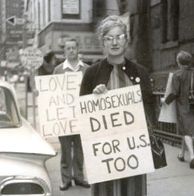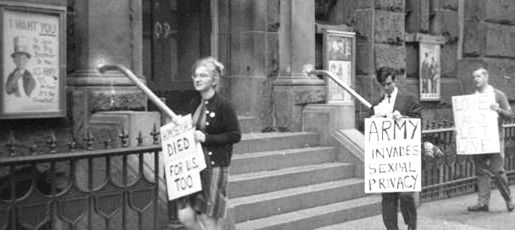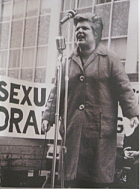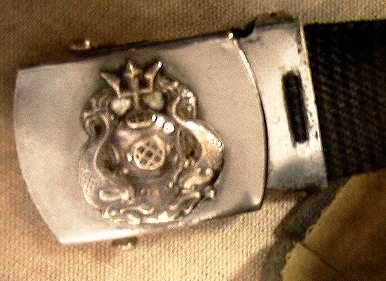Gay Vets Helped Form Backbone
of LGBT Equality
Movement
By Michael Bedwell
This year, we’ve seen the issue
of gays in the military draw more attention than any
time since 1993 when Bill Clinton’s goal of
eliminating the ban that had existed for more than
60 years was incinerated in a firestorm created by a
ruthless coalition of civilian and military
opponents to LGBT equality.
Some younger people seem to think
that the ban on gays actually started with Don’t
Ask, Don’t Tell, and too many older are unaware of
how long the issue has shared the top of the list of
demands for gay equality. Both tend to be unaware of
how many movement pioneers were/are veterans. It is
my considered opinion that this is because most LGBT
histories are written by those antipathetic to
anything related to the military.
Some believe that the gay
movement started with 1969’s Stonewall Riots in New
York City.
Others
say it started in Los Angeles in 1950 with the
Mattachine Society, and that it was the first gay
organization in the United States to continue for a
number of years after the first one, Chicago’s
Society for Human Rights, was quickly shut down in
1924.
In fact, that distinction goes to the
gay Veterans Benevolent Association, founded by four
honorably discharged gay vets in New York City in
1945. While they made some efforts to provide help
to gays that had gotten “blue discharges,” it was
primarily a social organization whose dances often
drew hundreds of attendees. It lasted nine years
until efforts by some to make the group more
political resulted in it imploding, and some of
those moving on to other gay groups that had formed
by then.
The more studious may know that
Henry Gerber was the primary founder of that earlier
historic Chicago group, but few seem to know that he
served in the United States Army in both WWI and
WWII.
Most LGBT histories insist that
the first demonstration for gay rights was the
picket of the White House in 1965. In fact, the
first was the year before when a handful of
protestors denounced the ban on gays in the military
at Manhattan’s Whitehall Induction Center. They were
led by multitalented movement pioneer Randy Wicker
and Craig Rodwell who, among his several
accomplishments, would open the first LGBT bookstore
in the United States, the Oscar Wilde Memorial
Bookshop.
|

Photos by Randy
Wicker 1964 |
 |
Sometimes people don’t realize
that parts of this history are right in front of
them. Entering the GLBT Historical Society’s
Passionate Struggle exhibit at 18th &
Castro in San Francisco, the first large photo one
sees is of late lesbian rights pioneer Del Martin,
cofounder with her partner Phyllis Lyon of the
Daughters of Bilitis [DOB]. The context of the photo
is unidentified so few visitors know it’s of Del
speaking to a crowd of 4-500 at a protest of the
military’s ban on gays at San Francisco’s Federal
Building on Armed Forces Day in 1966. Signs read,
"EVERY MAN HAS A RIGHT TO SERVE HIS COUNTRY,"
"SEXUALITY DOES NOT DETERMINE PATRIOTISM," and
“STOP WASTING TAX PAYERS’ $$$ ON WITCH HUNTS FOR
HOMOSEXUALS.”
One of simultaneous events
across the country Martin had suggested at the
National Planning Conference of Homophile
Organizations held that February in Kansas City,
Missouri, it was sponsored locally by DOB, the
Society for Individual Rights [SIR], the forerunner
of today’s Alice B. Toklas LGBT Democratic Club, the
Tavern Guild, et al.
 |
While Del and others were
speaking in San Francisco, former high school ROTC
member and Mattachine cofounder Harry Hay was one of
the leaders along with WWII Army veteran Don Slater,
the cofounder of legendary gay magazine ONE
who defeated the US Postal Service in a landmark
Supreme Court free speech case, of a motorcade
through some twenty miles of Los Angeles streets
protesting the ban. Thirteen car roofs carried
four-sided, four-foot tall signs with such messages
as, “10% OF ALL GIs ARE GAY,” and “WRITE LBJ TODAY.”
|
According to C. Todd White’s
Pre-Gay L.A., their Los Angeles Committee to
Fight Exclusion of Homosexuals from the Armed Forces
had earlier released a statement saying, “millions
of homosexual men and women have served with honor
as soldiers, sailors, airmen and marines in the wars
of our country” while having to “swear falsely
before the examining boards, denying the truth about
themselves under oath.” They urged people to write
the president and members of Congress, “to protest
this waste of needed manpower and the unjustified
denial of the right of a loyal citizen to serve his
country in war.”
In DC, movement icon and WWII
Army veteran Frank Kameny—at one time the only real
source of help to both active duty and veteran
gays—led a four-mile march from the White House to
the Pentagon, then flew to New York to speak at the
DOB-sponsored rally there. Other events were held in
Philadelphia and Kansas City. Together, the
demonstrations got more mainstream media attention
than any previous gay events, if not always
sympathetic. An LA Times columnist wrote,
“It’s almost tragic that they chose to make their
stand for acceptance by demanding the right to join
the army. Such a totally impractical idea turns a
serious social problem into material for a burlesque
skit.”
 |
At the back of the Historical
Society’s exhibit is the startling display that
often brings tears to the eyes of many who see it.
There under Plexiglas are the bloodstained suit,
shirt, tie, and shoes that Harvey Milk was wearing
when he was murdered. Few realize the significance
of the belt also in the case. Its buckle has the
insignia of a Master Diver which Harvey became
during his four years in the US Navy, and remained
proud of through his last breath. |
Kameny, Slater, and Milk were not
the only gay veterans to play major roles in the
broader LGBT movement. Mattachine cofounder Dale
Jennings, a WWII Army veteran, was the first to
publicly fight [and win] a phony police entrapment
case. SIR and Toklas cofounder Jim Foster, the first
out gay man to address a Democratic National
Convention [1972] had moved to San Francisco after
being kicked out of the Army for being gay. As
reported by Randy Shilts in Conduct Unbecoming,
during two weeks of interrogation, going over every
name in his address book, they asked,
“Sarah Whiteside, is she a dyke?”
“That’s my 84-yr. old great
aunt,” Foster replied.
“And this one—is she queer,
too?”
“That’s my grandmother.”
Jose Sarria, famous both as the
Widow Norton and the first out gay to run for public
office in the United States—in 1961, twelve years
before Harvey Milk,—is a WWII Army veteran. Gay
Games founder Dr. Tom Waddell represented the US
Army in the official Olympics. The Rev. Troy Perry,
who’s saved countless lives by building gays a
welcoming home for their starving souls with the
Metropolitan Community Churches, is also an Army
veteran.
In addition to Milk, Bay Area
Reporter founder Bob Ross was in the US Navy, as
was Herb Donaldson, California’s first out gay male
judge [and possibly the first in the nation], and,
before he became the beloved troubadour of Tales
of The City, author Armistead Maupin.
In rare cases, gay activism
preceded military service. Inspired, as so many, by
Frank Kameny, Robert Martin [aka Stephen Donaldson]
started the first gay student group at an American
university while attending Columbia in 1966. He
later enlisted in the US Navy and, after being
outed, was the first to publicly fight for an
honorable discharge.
Pat Bond, star of the early gay
documentary, Word is Out, escaped a witch
hunt in the WACs by marrying a gay man. To date, the
best known former gay US Marine has been Vietnam
veteran Oliver Sipple who saved President Gerald
Ford from an assassination attempt in 1975. And, of
course, the movement’s first internationally known
leader, Leonard Matlovich, went beyond fighting just
the military’s ban on gays to battles for equal
employment opportunity and adequate prevention and
treatment of HIV-AIDS.
With the advent of the
all-volunteer military, fewer LGBT activists today
involved in more than just the fight to end the
military ban are veterans, though there are
exceptions including West Point graduates and Iraq
veterans Anthony Woods and Dan Choi. Woods,
currently running for Congress, was discharged under
DADT, and, barring action by the President, Lt. Choi
soon will be.
But the leading roles the issue
of gay military service and gay veterans themselves
played in creating the broader movement for LGBT
equality mustn’t be forgotten.
“And if there were only some way
of contriving that a state or an army should be made
up of lovers and their loves, they would be the very
best governors of their own city, abstaining from
all dishonor, and emulating one another in honor;
and when fighting at each other’s side, although a
mere handful, they would overcome the world. “
Symposium, Plato.
---------------------------------------------------------------------------------------------------------------
Michael Bedwell is the former president of the gay rights group at
Indiana University and of DC's Gertrude Stein Democratic Club. He is also the creator of www.leonardmatlovich.com.
1964 Whitehall protest photos courtesy of Randy
Wicker.
The San Francisco
exhibit of the GLBT Historical Society continues
through October.
For more information:
www.glbthistory.org
For more
information about Anthony Woods:
www.anthonywoodsforcongress.com
For information about other gay vets:
http://www.leonardmatlovich.com/lgbtveteransgallery.html
